There are places in the world that grab you right away. Places where the beauty or energy, or maybe just the light, captures you from the start. Marseille tops my list. Paris. Amsterdam. Other places sneak up on you. Make you work a little harder, look a little more carefully.
For me, Berlin falls hard into this second category. I had built it up in my mind, based mostly on old images from news broadcasts and a lot of personal research and reading. And then I arrived there, armed with my imagination, and tried to make the imagined Berlin and the actual Berlin square with each other.
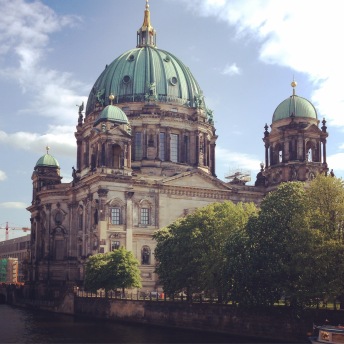 Berlin is not charming. It is not quaint. Traveling from the airport to our hotel by train, I began to grasp the size of the city. When we started walking, this sense of scale was confirmed. Berlin is sprawling, urban, complex. The architecture varies between 18th century neo-Classical and the more austere, functional design of the Communist era.
Berlin is not charming. It is not quaint. Traveling from the airport to our hotel by train, I began to grasp the size of the city. When we started walking, this sense of scale was confirmed. Berlin is sprawling, urban, complex. The architecture varies between 18th century neo-Classical and the more austere, functional design of the Communist era.
It was difficult to orient myself to the layout of the city and, more so, to order my own priorities. Everything felt steeped in significance. Every building, every plaque, every bit of graffiti seemed meaningful. It was like walking through a riddle, unable to crack the code needed to have it all make sense.
The obvious thing to do while I puzzled out Berlin was to have lunch, and drink some German beer. Most of our first day in the city was spent eating, or walking in search of the next snack, the next beer garden. There are worse ways to orient oneself to a place.
The next day, after a failed attempt to have a good German frühstück, we started out to see some of the remnants of the Berlin Wall. Our first stop was the East Side Gallery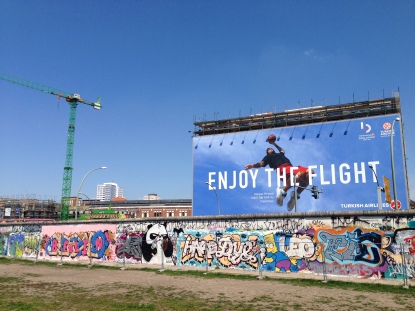 , a 1.3 kilometer stretch of the Wall with murals painted by dozens of artists, first in 1990, with several restorations done since. It sits oddly juxtaposed with a new luxury apartment tower. Construction cranes and ads for Turkish Airlines provide a somewhat surreal backdrop, and tourists take selfies in front of the graffiti-covered back side of the Wall.
, a 1.3 kilometer stretch of the Wall with murals painted by dozens of artists, first in 1990, with several restorations done since. It sits oddly juxtaposed with a new luxury apartment tower. Construction cranes and ads for Turkish Airlines provide a somewhat surreal backdrop, and tourists take selfies in front of the graffiti-covered back side of the Wall.
Next we went to the Berlin Wall Memorial, which was, in a word, excellent. The majority of the memorial is located outside, on a 1.4 kilometer stretch of Bernauer Strasse. In 1961, what became the Berlin Wall began as a barrier of barbed wire running down Bernauer Strasse, so low that residents could – and did – jump over it.
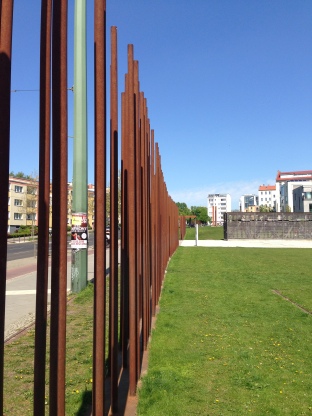
The historical and interpretative elements of the memorial are very powerful, and you understand immediately the effects that the Wall had, on families, on neighborhoods. Where the Wall once stood is now an installation of thousands of rebar-like markers. Nearby are the foundations of homes that were evacuated and later destroyed, as many served as escape routes to the West.
The continued “strengthening” of the Wall was necessary to prevent escapes. By the 1980s, the Wall was actually two walls, an inner and outer barrier, with a range of deterrents in the middle section, commonly known as the “death strip”. The Memorial shares stories of those killed in this section as they attempted escape. And then, as if to highlight the incredible changes since the Wall opened in 1989, two little boys arrive with their parents and start playing soccer. In the shadow of the Berlin Wall. In what used to be the death strip.
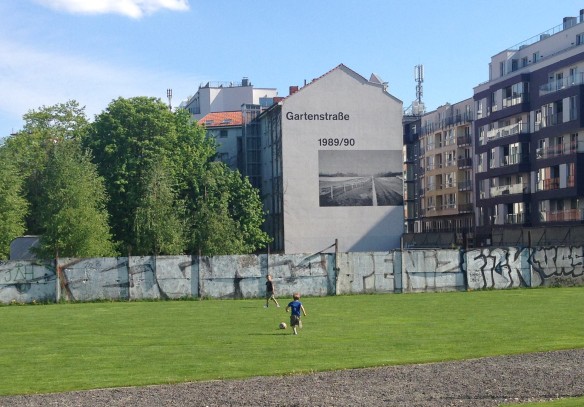
For the rest of our weekend in Berlin we balanced our somber experiences with relaxation and fun. We ate our way through the city on a “Beer and Currywurst Tour” led by Berlin Food Tours, sampling Berlin’s famous street food and enjoying beers at breweries and charming old neighborhood bars. The tour was excellent and our guide, Bastian, also showed us some street art and took us to the only known David Hasselhoff shrine in Berlin. The others on the tour – Australians, Brits, Brazilians, and an American couple on a round-the-world trip – were so much fun that we hung out with all of them again, some during the weekend and the Americans when they came through Amsterdam a few days later.

At the Pug Pub for a pilsner.
A more traditional walking tour gave us a good overview of the history of Berlin and allowed us to see all the major sites. (While very informative, that tour would have benefited from a beer or two.) I could have easily spent another week in Berlin, exploring museums and absorbing the history, and then enjoying the sun in a park or a beer garden.
This interplay between the past and the present is what made me fall for Berlin. The past is present – nothing of Berlin’s history is forgotten or white-washed. But Berlin is also very much living in the now. The city has an energy and an attitude that just captures you.
That might be the appeal of Berlin: the knowledge that what you see and feel now was created by Berlin’s people. In the aftermath of division, there came freedom and, ultimately, reunification. But in between those historical markers, there was unknown sacrifice, loss, struggle, joy, heroism. Those experiences created Berlin today. And the creation continues – no city, no society is ever done evolving. To witness that evolution, even for a few days, is to be inspired and encouraged about what is possible.
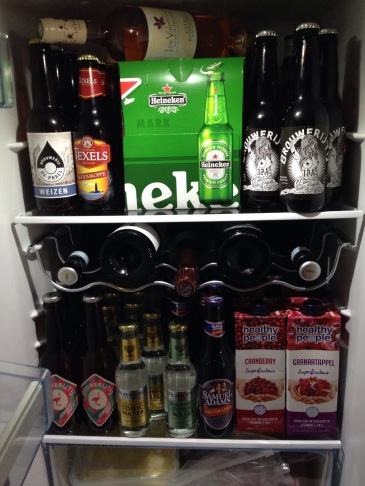
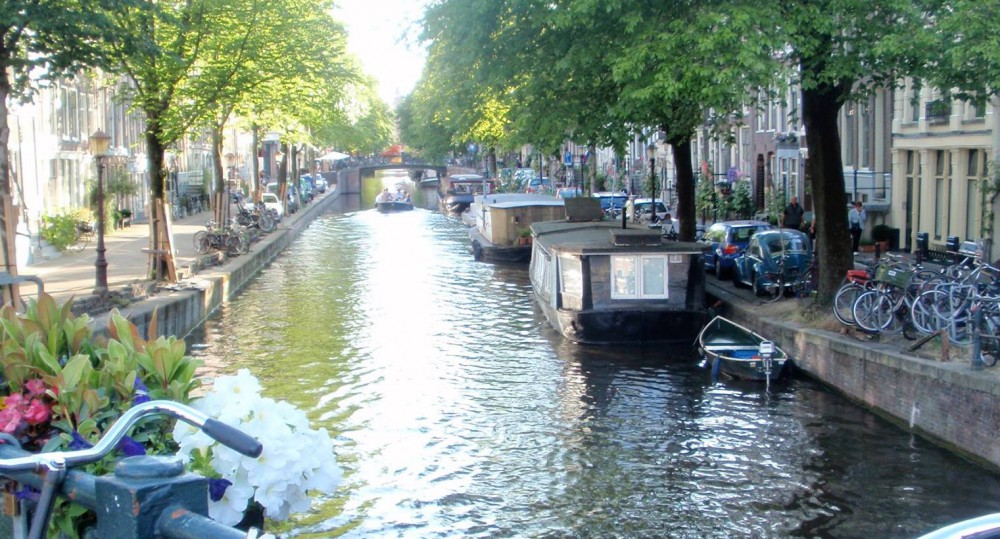
 Berlin is not charming. It is not quaint. Traveling from the airport to our hotel by train, I began to grasp the size of the city. When we started walking, this sense of scale was confirmed. Berlin is sprawling, urban, complex. The architecture varies between 18th century neo-Classical and the more austere, functional design of the Communist era.
Berlin is not charming. It is not quaint. Traveling from the airport to our hotel by train, I began to grasp the size of the city. When we started walking, this sense of scale was confirmed. Berlin is sprawling, urban, complex. The architecture varies between 18th century neo-Classical and the more austere, functional design of the Communist era. , a 1.3 kilometer stretch of the Wall with murals painted by dozens of artists, first in 1990, with several restorations done since. It sits oddly juxtaposed with a new luxury apartment tower. Construction cranes and ads for Turkish Airlines provide a somewhat surreal backdrop, and tourists take selfies in front of the graffiti-covered back side of the Wall.
, a 1.3 kilometer stretch of the Wall with murals painted by dozens of artists, first in 1990, with several restorations done since. It sits oddly juxtaposed with a new luxury apartment tower. Construction cranes and ads for Turkish Airlines provide a somewhat surreal backdrop, and tourists take selfies in front of the graffiti-covered back side of the Wall.

